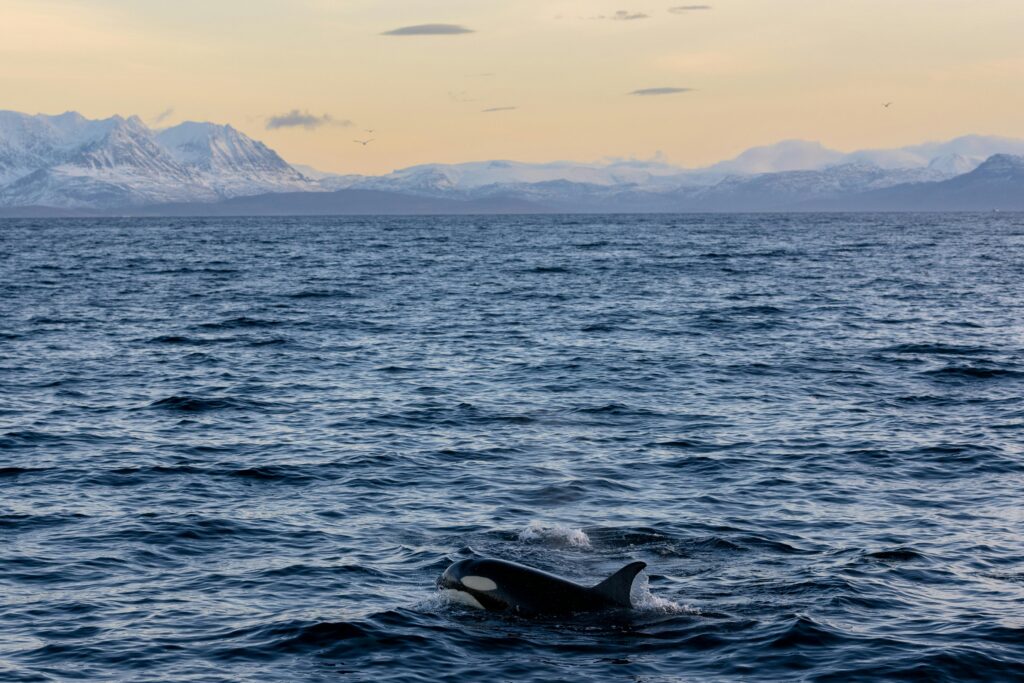Norway

Killer Whale
Norway is a country of edges — jagged coasts, deep fjords, high plateaus, and long light. It feels like a place stretched between worlds: where the sea meets the sky, where reindeer walk beneath auroras, and where silence holds more life than you’d expect. The wildlife here is stitched into the land — shaped by snow, shaped by salt, shaped by shadow. And if you move slowly enough through it, you’ll see: this northern wilderness is alive, powerful, and surprisingly tender.
Where the Wild Still Leads
Norway’s wildness is not loud or busy — it’s elemental. A white-tailed eagle hovering over a fjord. A moose stepping through birch under rain. A pod of orcas slicing through Arctic water with barely a ripple. From the forests of the south to the Arctic tundra in Finnmark, this is a land ruled by weather, shaped by light, and moved by ancient migrations.
Encounters Etched in Ice and Stone
Light, Season, and Survival
More than most places, Norway’s wildlife is tied to the light. In summer, days never end — and nature bursts into activity. Birds raise chicks, mammals roam freely, and the Arctic is filled with movement and calls. In winter, the world darkens — and the wild adapts. Moose dig through snow, lynx follow frozen trails, and reindeer trek across ice under northern lights. Every season reshapes the land — and every animal moves in rhythm with it.
Norway’s Wild Icons
A Land of Wilderness and Restraint
Norway’s wildlife asks for respect. It doesn’t leap out at you. It waits in stillness, just beyond the next bend. You hike to find it. You wait in weather. You learn to notice the sign — a ripple, a feather, a sound on snow. And when it comes into view, even briefly, it feels like being let into something sacred.
Final Reflections
In Norway, the wild is not a spectacle. It’s a presence. It shapes the way you move, the way you look, the way you feel the land beneath your feet. It’s in the curl of an orca’s tail. In the breath of a musk ox in the cold. In the hush after snowfall, when the sky glows violet and a single fox leaves tracks across the ice. Norway doesn’t try to impress you. And that’s why it does.
Where the Wild Still Leads
Norway’s wildness is not loud or busy — it’s elemental. A white-tailed eagle hovering over a fjord. A moose stepping through birch under rain. A pod of orcas slicing through Arctic water with barely a ripple. From the forests of the south to the Arctic tundra in Finnmark, this is a land ruled by weather, shaped by light, and moved by ancient migrations.
Encounters Etched in Ice and Stone
- Arctic Norway (Troms & Finnmark): Land of reindeer, sea eagles, and the northern lights. In winter, this is one of the best places in the world to see orcas and humpback whales — drawn by herring to dramatic fjords near Skjervøy and Andenes.
- Dovrefjell Plateau: Harsh, remote, and unforgettable. Home to Europe’s last wild musk oxen — shaggy, prehistoric survivors that walk like shadows through the tundra.
- Boreal Forests and Wetlands: Deep woods shelter lynx, elk, brown bears, and wolves — though most are shy and rarely seen. You’re more likely to find tracks than the animals themselves.
- Coastal Archipelagos (Lofoten, Vesterålen): Dramatic islands full of birdlife: puffins, razorbills, cormorants, and otters — set against wild seas and vertical cliffs.
- Svalbard: Technically part of Norway, this Arctic archipelago is a world apart — home to polar bears, walruses, Arctic foxes, and vast seabird colonies on glacier-cut cliffs.
Light, Season, and Survival
More than most places, Norway’s wildlife is tied to the light. In summer, days never end — and nature bursts into activity. Birds raise chicks, mammals roam freely, and the Arctic is filled with movement and calls. In winter, the world darkens — and the wild adapts. Moose dig through snow, lynx follow frozen trails, and reindeer trek across ice under northern lights. Every season reshapes the land — and every animal moves in rhythm with it.
Norway’s Wild Icons
- Musk Ox: Massive and shaggy, they roam the Dovrefjell like ghosts of the Ice Age. Often seen at a distance — unforgettable in storm or snow.
- Orca: Sleek and social — best seen in winter months in northern fjords, chasing herring in coordinated pods.
- White-Tailed Sea Eagle: Huge wingspan, fierce eyes — seen almost daily along the coast, especially in Lofoten and the fjords of the west.
- Arctic Fox: Perfectly adapted to cold, often spotted on Svalbard or remote northern plateaus. Rare, but increasingly protected.
- Reindeer: Domesticated and wild herds exist — especially in Sámi territories, where they’re part of both ecology and culture.
A Land of Wilderness and Restraint
Norway’s wildlife asks for respect. It doesn’t leap out at you. It waits in stillness, just beyond the next bend. You hike to find it. You wait in weather. You learn to notice the sign — a ripple, a feather, a sound on snow. And when it comes into view, even briefly, it feels like being let into something sacred.
Final Reflections
In Norway, the wild is not a spectacle. It’s a presence. It shapes the way you move, the way you look, the way you feel the land beneath your feet. It’s in the curl of an orca’s tail. In the breath of a musk ox in the cold. In the hush after snowfall, when the sky glows violet and a single fox leaves tracks across the ice. Norway doesn’t try to impress you. And that’s why it does.
